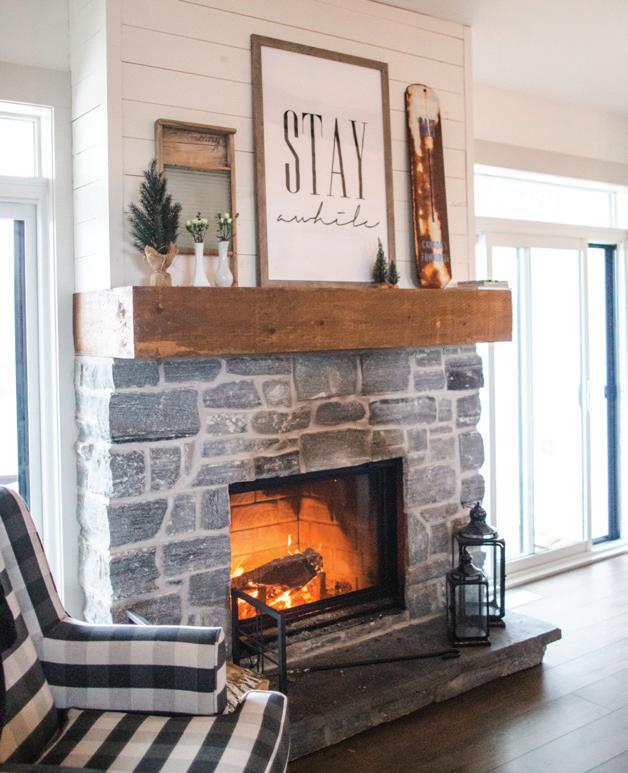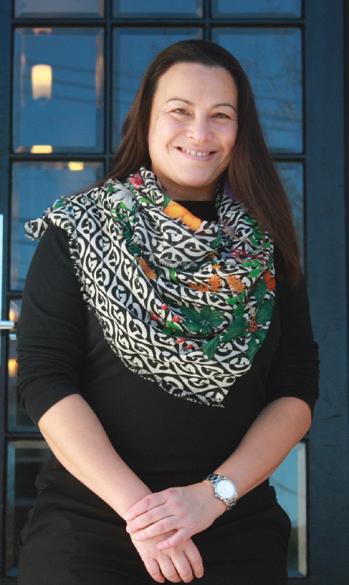
16 minute read
INSPIRE
Inspire DESIGN TRENDS
When landscaping, opt for plants like lilac and sage, which are both drought-tolerant and fire-resistant.
The Beauty of FIRE-RESISTANT LANDSCAPING

A fire-resistant landscape isn’t necessarily the same thing as a well-maintained yard. This type of landscape uses fire-resistant plants that are strategically planted to resist the spread of fire to your home. Fire-resistant plants are great in California because they are often drought-tolerant, too.
The good news is, you don’t need a lot of money to make your landscape fire-resistant. And you will find that a fire-resistant landscape can increase your property value and conserve water while beautifying your home. • Choose fire-resistant plants and materials • Create fire-resistant zones with stone walls, patios, decks and roadways. • Use rock, mulch, flower beds and gardens as ground cover for bare spaces and as effective firebreaks. • There are no fireproof plants. Select high-moisture plants that grow close to the ground and have a low sap or resin content. • Choose fire-retardant plant species that resist ignition such as rockrose, ice plant and aloe. • Select fire-resistant shrubs such as hedging roses, bush honeysuckles, currant, cotoneaster, sumac and shrub apples. • Plant hardwood, maple, poplar and cherry trees that are less flammable than pine, fir and other conifers. • Check your local nursery, landscape contractor or county’s UC Cooperative Extension service for advice on fire-resistant plants that are suited to your area.
FRENCH LAVENDER is a fire-resistant plant that thrives in dry growing conditions. This low-key plant will add beauty to your defensible space landscape.
The fire-resistant RED MONKEY FLOWER yields beautiful bright red blossoms. This evergreen shrub is also drought-tolerant and a California native species.
The deer-resistant CALIFORNIA FUCHSIA has bright orange-red funnel-shaped flowers. This perennial is firesafe and needs little to no water once established.
SAGE is a low-maintenance plant that provides fire resistance while being drought-tolerant.
The CALIFORNIA LILAC is a colorful shrub. The fire resistant plant is drought-tolerant and is covered with small pink and purple flowers when in bloom.
This common landscape plant is a smart choice: the SOCIETY GARLIC is firesafe and grows in drought prone regions.
The ORNAMENTAL STRAWBERRY is a great ground cover plant. This fire-resistant plant can be used to give a lush look to your landscape.
The YELLOW ICE PLANT is a very low-growing ground cover with succulent, green foliage. This succulent requires very little watering and is fire safe.
The COREOPSIS PLANT is popular, due to its tolerance to a wide variety of soil types. It’s firesafe, making it the perfect addition to your landscape.
The CALIFORNIA REDBUD is another colorful shrub that’s fire-resistant, drought-tolerant and covered with small pink and purple flowers when in bloom.
Visit readyforwildfire.org to see photos of these flowers and to learn more wildfire-preparedness tips from CAL FIRE.

Networking | Education | Advocacy
Sequoyah Country Club
Wednesday, September 29, 2021 | 1–5 p.m.
EBRHA 360, the association’s newly branded annual trade expo, is committed to providing a complete perspective of what it takes to succeed as a rental property owner or manager in the East Bay. Covering every angle and aspect of the rental housing industry, EBRHA 360 promises an immersive experience that empowers housing providers with the knowledge, tools, and resources they need to stay on top of a constantly evolving sociopolitical landscape. In alignment with our ongoing “Community Forward” initiative, the EBRHA 360 Trade EXPO welcomes all members of the rental housing community in Alameda and Contra Costa counties.



ABOUT THE EXPO
EBRHA’s much-anticipated Annual Trade Expo is back this fall! Join us on September 29, 2021, at the Sequoyah Country Club in Oakland, CA, for our EBRHA 360 Trade EXPO - 2021. The spectacular Sequoyah golf course is the perfect backdrop for housing providers and suppliers to interact face-to-face, share rental housing best practices, and understand the latest policies impacting rental property owners and managers. The venue offers expansive indoor and outdoor spaces, ideal for safe interaction and social distancing. We’re excited to reunite in person with our members and the East Bay rental housing community after a long, unanticipated hiatus since September 2019. Enjoy the tranquil setting and breathtaking views of the country club as you expand your knowledge and forge meaningful connections with fellow attendees.
WHO CAN ATTEND
Owners/managers of rental property in Alameda and/or Contra Costa counties and suppliers serving East Bay housing providers can attend. Suppliers include Government agencies, Accounting & Tax professionals, Attorneys, Banking/Lending companies, Builders/ Remodelers, General Contractors, Electricians, Financial Planners, Property Maintenance and Management companies, and other service providers such as Insurance Brokers, Security Services, Pest Management, and Litigation Support Services.
WHY ATTEND
SPONSOR-EXHIBITOR PACKAGES
Discover new solutions to rental housing challenges, expand your network of likeminded professionals, and elevate your knowledge on current rental housing policies and practices, all under one roof in an actionpacked trade EXPO event!

STANDARD $1,000
FREE GA Tickets: 2 *Exhibitor Space (Standard Level) Rental Housing Magazine Promotional Mention Sponsor Exhibitor Directory (List - After Premium) Digital Logo Feature (select creatives only)*
*Expo space for exhibitors is optional and not required
PREMIUM $2,500
FREE GA Tickets: 4 *Premium Exhibitor Space (Premium Level]) 1/4 Print Ad - Rental Housing*
Sponsor Exhibitor Directory (List - Premium)
Premium Ad Placement (select creatives)
Social Media Features (select posts) Premium Logo Placement - Name Tag BRONZE Digital Advertising*
FREE GA Tickets: 6 *Elite Exhibitor Space (Elite Level) 1/2 Print Ad - Rental Housing* Sponsor Exhibitor Directory (Elite w/ logo)
Priority Ad Placement (select creatives)
Social Media Features (select posts) Priority Logo Placement - Name Tag SILVER Digital Advertising*
Preferred Parking
Video Presentation FREE GA Tickets: 12 *VIP Exhibitor Space (VIP Partner Level)
Full Page Print Ad -
Rental Housing* Sponsor Exhibitor Directory (VIP w/ logo & description) VIP Ad Placement in ALL Print Creatives Social Media Features in
ALL Promotional Post
VIP Logo Placement - Name Tag GOLD Digital Advertising* Valet Parking VIP Access/Speaker Rights
Logo Feature on
ALL Expo Signage (includes promotional)
Private Seating/
Networking Space

ELITE $5,000
VIP PARTNER $10,000
Take simple steps to protect your property from wildfire.

Wildfire-Season Tips
TO PROTECT YOUR PROPERTIES
Courtesy of Yardi Breeze
Wildfire season can be a tough time for property managers, owners, residents, businesses and virtually everyone who lives in affected areas. And it’s not just California and the American West that are experiencing a rate and intensity of wildfires like never before.
Whatever the causes (e.g., climate change, forest management), property managers need to prepare their properties for natural disasters including wildfires. Here are some tips to help protect and fireproof your property.
1. CREATE A FIRE-RESISTANT, DEFENSIBLE SPACE AROUND THE PROPERTY
If you live within one of California’s State Responsibility Areas, you are required by law to create and maintain a “defensible space” around your property. This space must be clear of any natural growth or brush that could facilitate the spread of a wildfire.
Defensible spaces can be a good idea, even if you don’t live in California or you’re not required to make them. If fire season is a problem in your region, chances are it’s a bigger problem than ever before. Consider doing everything you can to protect your properties and the people who live there. [Editor’s note: In Contra Costa and Alameda counties, property owners are responsible for managing their vegetation to meet fire district requirements. Check with your local fire department for details.]
2. MAKE WATER SOURCES AVAILABLE TO FIRST RESPONDERS
Want to help first responders protect your property in the event of a fire? Connect a garden hose into available water lines, and leave them connected during fire season. Fire departments will use any tools at their disposal.
Hydrants, ponds and pools can be used to fight fires. Make sure first responders have easy access to these resources at all times.
Also, the curb around hydrants and fire access areas should be kept freshly painted so it’s clearly defined and easy to see.
3. KEEP ROOFING & GUTTERS CLEAR OF DEBRIS
As part of your fall maintenance, gutters, roofing and lawns should be free of obstructions such as leaves and dead grass.
Gutter-cleaning may sound straightforward, but it’s surprisingly dangerous work. Ladders can slip or people can fall, especially when you or your maintenance team is leaning and reaching to clear out clogged gutter systems. The job can be kept safer with high-quality cleaning tools and ladder stabilizers. Even so, a professional contractor may be worth the additional cost of labor.
4. USE THE RIGHT ROOFING MATERIALS
Do you know the fire rating for your property’s roofing material? Roofs are classified as Class A, Class B, Class C or unrated. Class A materials are the most fire-resistant, and unrated materials offer the least amount of fire protection.
Ahead of wildfire season, it’s important to protect your property with Class A materials. The rating could apply to several types of material: • Concrete • Clay • Fiberglass asphalt • Metal • Wood (if treated to meet Class A requirements)
A professional roofing service can provide the best consultation and options for your property.
5. CREATE AN EXIT PLAN FOR YOUR TEAM & RESIDENTS
One of the best ways to protect your community is to provide your residents with an exit plan in case of an emergency. This is something you can easily text or email via Yardi Breeze, which ensures the information never gets lost (and is easy to resend). • Provide wildfire-season evacuation routes to nearby emergency shelters • Ask residents to close windows and doors before evacuating • Establish special roles for your team so residents know whom to contact with questions • Practice fire drills with your office • Make sure emergency exit routes are posted around your property as required by law

6. COVER YOUR ASSETS WITH A DWELLING FIRE POLICY
Breeze makes it easy for you to provide renters insurance. Many property managers are able to sign renters up with its preferred provider, ResidentShield, during the online lease signing. This type of insurance does not cover your property from wildfire damage, but it does cover your residents’ belongings. It also provides temporary living expenses if the residence is uninhabitable due to a covered loss. *What about homeowners insurance?
It’s a mistake to try to cover your property with homeowners insurance. Owner-occupants, whom homeowners insurance is meant for, face different risk factors (and pricing) than rental property owners. Only the right dwelling fire (aka landlord) insurance policy can cover your property for wildfire damage. Make sure you’re properly covered so you never have to worry about facing a denied claim.
Disclaimer: This article is meant for informational purposes only and does not constitute nor replace legal counsel. Consult a professional service to determine the fire readiness of your properties. And please approach fire safety with extreme caution. Wildfires that are hot enough and/or move quickly enough can easily thwart your best preparation efforts.
Source: yardibreeze.com/blog/2020/10/wildfire-season-tips-protect-fireproof-your-properties, published October 20, 2020
PREPARE FOR EARTHQUAKES
All buildings in earthquake territory should be constructed with safety in mind. That includes adding extra support to cripple walls (walls that separate crawl spaces from the rest of the house), which can move during an earthquake. Other steel supports should be added to walls as determined by engineers and professional contractors.
Your residents can help themselves, too. They can secure dressers, bookshelves and TV stands to walls. Any furniture that comes with the unit should be designed with earthquake safety in mind. Encourage your residents to do the same with their personal belongings.
As with other disasters, residents should follow emergency instructions. If a property is damaged, communicate your plan of action and instruct residents not to return home until it is safe. [Editor’s note: Visit Earthquake Country Alliance, Bay Area for more tips: earthquakecountry.org/bayarea/] Source: yardibreeze. com/blog/2019/07/how-prepare-your-properties-natural-disasters, published July 12, 2019


NATURAL DISASTER EMERGENCY CHECKLIST
Below are a few simple safety precautions that apply to most natural disasters. Communicate them to your residents via email or text. Encourage your residents to:
• Have emergency food and water for three to seven days because the first 72 hours after a disaster are the most important for safety and survival (it should be portable, in case they need to relocate) • Put together an emergency kit that includes first aid • Stock flashlights with extra batteries • Keep extra blankets, gloves, coats, etc. • Invest in an emergency radio • Come up with an emergency meeting point (not in their residence) for immediate family members, in case they can’t communicate with each other and can’t go home • Ask an out-of-state friend or family member to be an emergency contact that can help coordinate with everyone
Source: yardibreeze.com/blog/2019/07/how-prepare- your-properties-natural-disasters, published July 12, 2019 LOCAL FIRE AND DISASTER PREP RESOURCES
Cal Fire: fire.ca.gov | readyforwildfire.org Contra Costa County Fire Protection District: cccfpd.org | cccfpd.org/ResidentsWildlandFireGuide Contra Costa County Community Warning System: cwsalerts.com Alameda County Fire Department: fire.acgov.org Alameda County Emergency Preparedness Page: acgov.org/ready AC Alert: acalert.org

all in the FAMILY
4 Keys to Preserving Multifamily Legacy
by Jennifer Loh
MONKEY BUSINESS/ADOBE STOCK Multifamily real estate is one of the most powerful, life-changing gifts one can bestow upon a loved one. For many investors, particularly families, inheritance is a well-intentioned gesture meant to provide financial independence and security to last lifetimes. And yet, far too often, this life-altering event results in intra-family disputes—a byproduct caused by broken communication and fractured relationships, sometimes far beyond repair.
For smaller rental property owners, a “set it and forget it” mindset naturally develops when acquisition and disposition events occur 15-20 years apart or longer. Rents are collected; bills are paid; and tenants come and go. Add the distractions of everyday life, and it becomes even more challenging to proactively position heirs for long-term success.
In the multifamily world, real-time circumstances and scenarios teach us the ins and outs of the business. There are legalities to follow and instincts to develop. Typically, heirs who inherit property lack experience in property management and multifamily investing, making it exceptionally challenging for any newcomer to navigate. When multiple siblings or family members enter these new waters together, unfamiliar roles are assumed, and the family dynamic forcibly evolves: What are the new responsibilities and tasks at hand? How are decisions made and agreed upon? How are disagreements settled? Further complicating matters are relatives or members of the partnership misaligned from the vision and overall goals of the portfolio—some may prefer to cash out, while others wish to continue. While there are many layers to every scenario, the inadvertent lack of planning is one of the underlying forces causing conflict, which too commonly escalates into heartbreaking scenarios.
As multifamily brokers, operators and housing providers, our goal is to help families navigate the transition as smoothly and peacefully as possible. Below are four keys to preserving your multifamily legacy.
1. OPEN CONVERSATIONS
While it is commonplace for investors to take the necessary legal steps to ensure real estate passes to the proper parties, go beyond the paperwork to have meaningful conversations with those who stand to inherit ownership. There are limitless benefits in explaining your beliefs, philosophies and contexts behind your multifamily real estate; primarily, heirs will have a better understanding of your investments and appreciate your achievements meant to be carried forward.
2. MAKE INTRODUCTIONS
If you self-manage, start integrating your loved ones by involving them in management matters and tasks. Expose them to real-life situations like fielding a maintenance request, collecting laundry money and/or reconciling monthly billing. If your property is managed by a team of professionals, facilitate relationships by making the proper introductions and encouraging collective decision-making.
3. WORK WITH PROFESSIONALS IN ADVANCE
It is never too soon to establish the groundwork for a succession plan. Be sure to engage the proper professionals (estate planners and tax specialists) well in advance to ensure this is done properly. It is also critical to work with a multifamily specialist who understands both the short-term and longterm goals of your portfolio—a capable professional wellequipped to manage your assets, advise on timing and align all decisions with the bigger picture.
4. EXPRESS YOUR WISHES
How do you envision your family using this gift? Do you have any specific instructions or matters of importance to you? By expressing your intentions upfront, your heirs will have a road map for future guidance.
While a clear and concise succession plan is the first and most important step in planning, going a few steps further will help eliminate surprises, prevent conflicts, preserve relationships and set your loved ones up for success well into the future.

TALKING PROP 19
In November 2020, Californians voted to pass Proposition 19 by a thin margin. The previous law permitted parents to transfer their principal residence of unlimited value, plus up to $1 million of base-year value of any nonprincipal residence properties to their children, without triggering reassessment. Prop 19 severely limits these nonreassessment transfers. As of February 16, 2021, the parent-to-child reassessment exclusion is limited to the principal residence of the parent and requires that the child utilize the property as their own principal residence. Additionally, even if the child utilizes the residence as their own, there is a cap of $1 million on the exclusion.
This tax change not only impacts how much heirs stand to benefit from inheriting your property, but also could lead to tough conversations among siblings. Certainly it should influence planning for those transfers. Making informed decisions together with your attorney and CPA can save money ... and preserve family relationships.

Jennifer Loh graduated with a bachelor’s degree in legal studies from the University of California, Berkeley. After subsequent studies at Stanford University and Harvard University, she lived in Shanghai, China, then returned to the U.S. to earn her real estate license in 2005.
For over a decade, Jennifer has held various roles with her family’s real estate companies: Wellington Property Company and LOH Realty & Investments. As a Leased Investment Specialist at WPC, she has executed more than 1000 multifamily and residential leases for properties throughout the East Bay. In 2019, Jennifer earned her California broker license and transitioned to multifamily sales, with a focus on serving individual and family-owned portfolios. In 2020, she closed $18.1M in transactions while completing the CCIM curriculum. Jennifer is currently an active Multifamily Broker, finalizing her $30M portfolio for the two-day qualifying CCIM exam to officially complete the designation.











